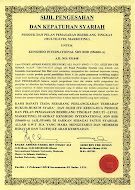Saturday, September 13, 2008
TEACHING OF MATHS AND SCIENCE IN ENGLISH:
Study reveals policy's flaws 
By : Elizabeth John and Aniza Damis TANJUNG MALIM: Five years after schools began teaching Mathematics and Science in English, tests on thousands of students have revealed poor scores in these subjects.
Universiti Pendidikan Sultan Idris (UPSI) put over 3,000 Year Five pupils and about 2,800 Form Two students around the country through short Mathematics, Science and English language tests between February last year and January.
The schoolchildren were from a mix of urban, rural and vernacular schools in Peninsular Malaysia.
The tests were made up of modified past-year examination questions. Some were taken straight out of textbooks.
Some 1,700 Year Five pupils tested this January had a mean score of 7.89 out of a maximum 20 for Mathematics.
The results were not much better for Science: a mean of 4.08 out of 14. English proficiency was not good either: a mean of 11.87 out of 31.
The mean scores of Malay and Orang Asli pupils were also much lower than those of the Chinese and Indians, said study leader Professor Emeritus Datuk Isahak Haron.
Isahak has called the policy a failure, particularly in terms of its impact on Malay students in national schools (Sekolah Kebangsaan), and is asking for a return to the teaching of Mathematics and Science in Bahasa Malaysia.
In the survey, many Year Five pupils told researchers they found it hard to learn Mathematics and Science in English, saying they did not understand the lessons.
In one sample, less than a fifth of the Year Five Malay students surveyed considered it easy to learn Science in English and only about a third thought it was easy to learn Mathematics in English.
When a sample of 1,300 Malay students were asked how well they understood the Mathematics and Science lessons when it was taught in English, over 60 per cent said they only understood the lessons "sometimes".
The policy had even failed in its aim of improving the pupils' command of English, said Isahak, a lecturer at the Faculty of Cognitive Science and Human Development.
Students struggled to correctly complete even simple sentences, he said, citing the following sentence in a passage taken out of a school textbook: "He ..... to bed" (The answer is "went".)
An average of 14 per cent and 19 per cent (two different groups) got the answer right.
Even the highest score according to racial breakdown -- 41 per cent of Chinese students in one group answered correctly -- did not speak well of the policy's aim of improving English.
Isahak suggested that it would do more good to allocate more time, staff and money to the teaching of English at the primary school level.
He urged a change in how the language was taught in schools. He said the standardised syllabus should be scrapped in favour of lessons tailored to suit the abilities of different students.
The UPSI study also incorporated findings from other surveys of secondary school students that pointed to similar problems.
Shortly after the policy was implemented in 2003, Associate Professor Hashima Jalaluddin of Universiti Kebangsaan Malaysia interviewed 43 teachers and 971 Form One students from six schools in the central and southern states of Peninsular Malaysia .
Most of the teachers said students had problems following Mathematics and Science lessons in English, while 70 per cent of the students said they would be more interested if the two subjects were taught in Bahasa Malaysia.
Only a quarter said they had no problem following the lessons in English.
In 2004, Zainuddin Bikum surveyed 229 students in two schools in Kuala Kubu Baru, Selangor, for his dissertation at UPSI and found that more than half of the group was facing difficulties.
Universiti Kebangsaan Malaysia's Professor Juriah Long found that about half the students in both urban and rural schools were worried because they found it difficult to follow Mathematics and Science in English. This was one of the results of her 2005 survey of over 7,000 Form Two students nationwide.
Her study, which also looked at the location of schools and the socio-economic background of students, found the concern was greater among Malay students, those in rural schools, and poor students.
Isahak said Malay students in national schools, mostly in rural areas and from lower socio-economic backgrounds, had lost out the most as a result of the decision to teach Maths and Science in English.
The ones who gained from the policy were a small percentage of Malay students from upper middle class families who went to good schools, he said.
However, UPSI's own test results showed Year Five Malay students from rural schools scored highest in nine out of 10 Maths questions and two out of seven Science questions compared with Malay students in big town and city schools.
Meanwhile, Malay students in city schools consistently fared the lowest.







0 comments: to “ ”
Post a Comment